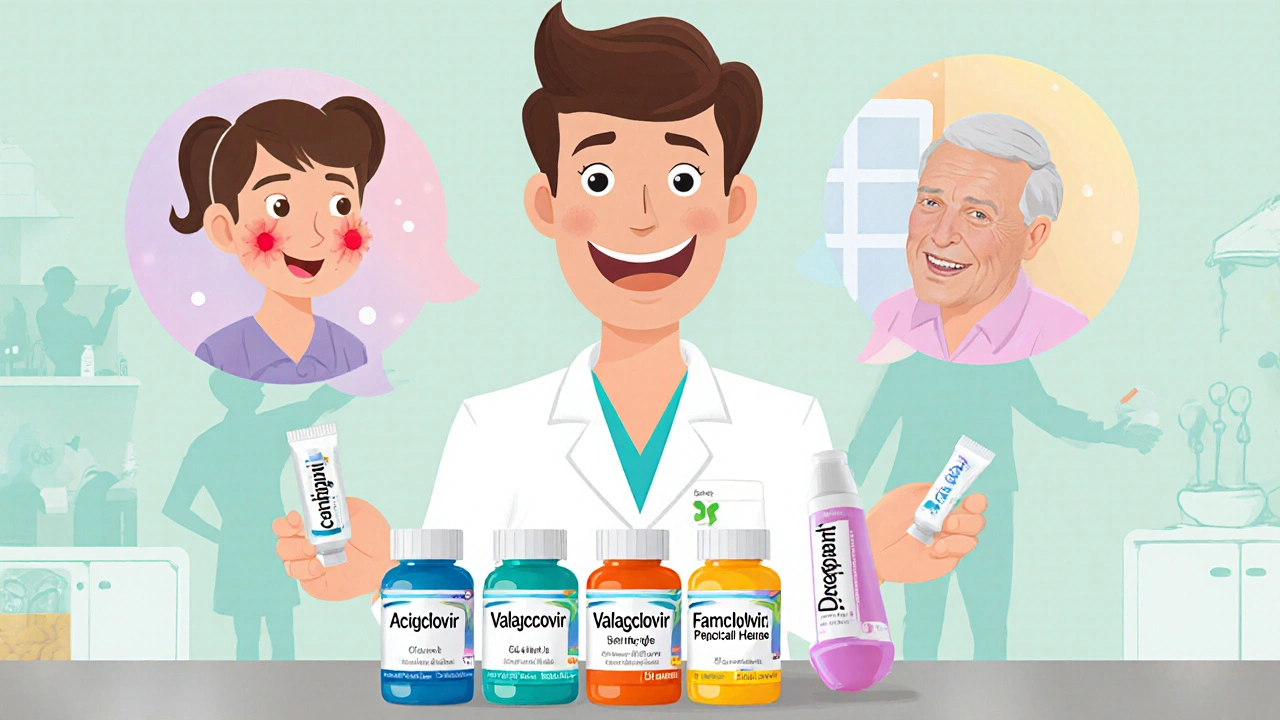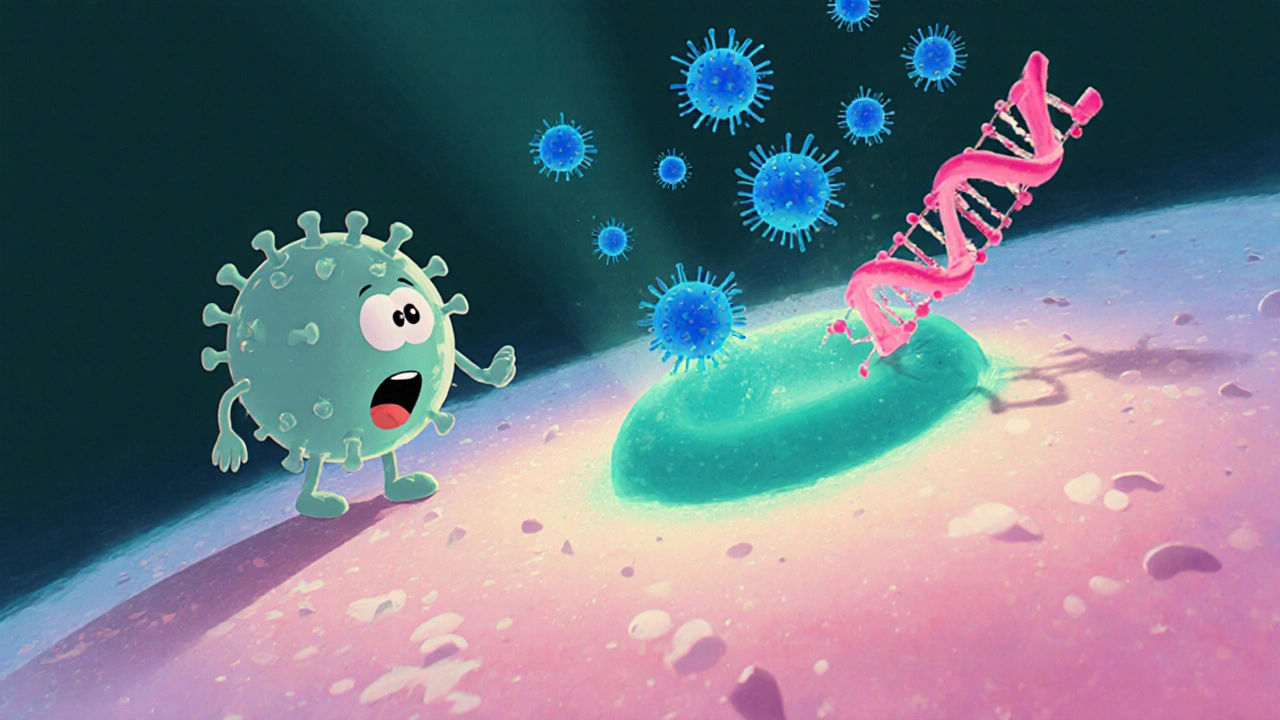Quick Takeaways
- Aciclovir works by blocking viral DNA replication and is the oldest oral antiviral for HSV and VZV.
- Valacyclovir offers higher bioavailability, meaning fewer pills for the same effect.
- Famciclovir is another prodrug with a longer half‑life, useful for shingles.
- Topical penciclovir and docosanol act locally; they are best for mild cold‑sores.
- Safety profiles are similar, but kidney function and drug interactions differ across the class.
What is Aciclovir?
Aciclovir is a synthetic nucleoside analogue that mimics guanosine. It interferes with viral DNA polymerase, preventing the virus from multiplying. First approved in 1982, it quickly became the go‑to oral drug for herpes simplex virus (HSV‑1, HSV‑2) and varicella‑zoster virus (VZV).
Its low cost and decades of safety data keep it popular, especially in generic form.
How Aciclovir Works
The drug is activated by a viral enzyme called thymidine kinase, which is present only in infected cells. Once phosphorylated, Aciclovir gets incorporated into the viral DNA chain, causing premature termination. This selectivity means healthy cells are largely spared, reducing side‑effects.
Clinical Uses of Aciclovir
- Treatment of primary and recurrent genital herpes.
- Management of oral herpes (cold sores).
- Therapy for shingles (herpes zoster) in immunocompetent adults.
- Prophylaxis in transplant patients and neonates at risk.
Typical adult dosing for genital herpes is 400mg five times daily for 7‑10days, while shingles regimens use 800mg five times daily for 7days.
Aciclovir vs Valacyclovir
Valacyclovir is the L‑valine ester of Aciclovir, designed to improve oral absorption. It reaches plasma concentrations 3‑5 times higher than the same dose of Aciclovir.
- Bioavailability: Valacyclovir ~55% vs Aciclovir ~15‑30%.
- Dosing convenience: Valacyclovir often requires twice‑daily dosing, whereas Aciclovir may need five times daily.
- Cost: Aciclovir generic is cheaper, but insurance formularies sometimes prefer Valacyclovir for adherence reasons.
- Kidney considerations: Both need dose adjustment in renal impairment, but the higher plasma peaks of Valacyclovir can increase crystal‑formation risk if hydration is poor.
For recurrent genital herpes, a 1g daily dose of Valacyclovir is as effective as a 400mg five‑times‑daily Aciclovir regimen.

Aciclovir vs Famciclovir
Famciclovir is the diacetyl prodrug of penciclovir, another guanosine analogue. After oral ingestion, it converts to penciclovir, which has a longer intracellular half‑life (approximately 14hours) than Aciclovir’s 3‑5hours.
- Half‑life advantage: Famciclovir can be taken three times daily, offering better compliance than Aciclovir’s five‑times schedule.
- Shingles efficacy: Clinical trials show Famciclovir reduces post‑herpetic neuralgia risk slightly better than Aciclovir when started within 72hours of rash onset.
- Side‑effect profile: Both share headache and nausea; Famciclovir may cause fewer gastrointestinal complaints.
- Renal dosing: Adjustments are similar, but the longer half‑life means less frequent monitoring in stable patients.
Typical dosing for shingles: 250mg three times daily for 7days.
Topical Alternatives: Penciclovir
Penciclovir is a topical antiviral cream (1%) approved for cold‑sores. Unlike oral drugs, it stays on the skin, delivering high concentrations directly to the lesion.
- Application frequency: Five times daily for 4days, started at first sign of tingling.
- Efficacy: Reduces healing time by about 1 day compared with placebo; not as fast as oral Aciclovir for severe outbreaks.
- Safety: Minimal systemic absorption, making it safe for pregnant women and patients with kidney disease.
For occasional mild cold‑sores, penciclovir can be a convenient over‑the‑counter option.
Topical Alternatives: Docosanol
Docosanol (5% cream) works by blocking the fusion of the herpes virus with cell membranes. It does not need activation by viral enzymes.
- Onset of use: Apply five times daily at the first sign of a cold‑sore.
- Effectiveness: Clinical data show a modest reduction in lesion duration (about 0.5‑1day).
- Side‑effects: Mostly local irritation; no systemic concerns.
Docosanol is the only OTC antiviral approved by the FDA, making it attractive for people who prefer self‑management.
Safety, Interactions, and Special Populations
All five agents share common adverse events-headache, nausea, and mild renal impact. Major differences arise from drug‑drug interactions.
- Aciclovir can increase serum levels of probenecid, which may be used to boost its own concentrations.
- Valacyclovir interacts with didanosine, a nucleoside analogue used in HIV therapy, raising the risk of pancreatic toxicity.
- Famciclovir’s conversion to penciclovir is inhibited by cimetidine, a gastric acid reducer.
- Topicals (penciclovir, docosanol) have negligible systemic interactions.
Renal dosing guidelines (based on creatinine clearance) are essential for the oral agents. Pregnant women can safely use Aciclovir, Valacyclovir, and topical forms; Famciclovir is category B but data are limited.
Choosing the Right Antiviral
The decision hinges on three factors: severity of infection, need for dosing convenience, and patient‑specific considerations (kidney function, pregnancy, adherence).
- Mild, occasional cold‑sores: Topical penciclovir or docosanol.
- Frequent genital outbreaks: Valacyclovir 500mg daily for suppression-fewer pills, better adherence.
- Shingles in older adults: Famciclovir 250mg TID; its longer half‑life simplifies dosing.
- Cost‑sensitive settings: Generic Aciclovir remains the cheapest oral option.
Always assess renal function before prescribing any oral nucleoside analogue.
Quick Comparison Table
| Drug | Form | Bioavailability | Typical Dosing Frequency | Best Use Case |
|---|---|---|---|---|
| Aciclovir | Oral tablet / suspension | 15‑30% | 5× daily | General HSV/VZV, low‑cost settings |
| Valacyclovir | Oral tablet | ≈55% | 1‑2× daily | Recurrent genital herpes, adherence focus |
| Famciclovir | Oral tablet | ≈77% | 3× daily | Shingles, long‑duration suppression |
| Penciclovir | Topical 1% cream | Topical (local) | 5× daily | Mild oral lesions, pregnancy safe |
| Docosanol | Topical 5% cream | Topical (local) | 5× daily | OTC cold‑sores, quick self‑treatment |
Checklist Before Starting Therapy
- Confirm diagnosis (HSV‑1, HSV‑2, VZV).
- Assess renal function (creatinine clearance).
- Check for concomitant medications that affect renal excretion or share metabolic pathways.
- Discuss pregnancy or breastfeeding status.
- Choose formulation based on frequency tolerance and cost.
Frequently Asked Questions
Can I switch from Aciclovir to Valacyclovir without a doctor?
Switching requires a prescription because dosing differs and kidney function must be re‑evaluated. Talk to your healthcare provider before changing.
Is Aciclovir safe for children?
Yes, pediatric dosing is weight‑based and widely used for neonatal HSV infections. Always follow a pediatrician’s guidance.
Why does Aciclovir need to be taken five times a day?
Its short half‑life means plasma levels drop quickly. Frequent dosing keeps the drug concentration above the level needed to stop viral replication.
Can I use topical penciclovir together with oral Aciclovir?
Yes, combining them can speed up lesion healing, but it isn’t usually necessary for mild cases. Consult a clinician if you have severe or frequent outbreaks.
What should I do if I miss a dose of Aciclovir?
Take it as soon as you remember unless it’s almost time for the next dose. Do not double‑dose.


Johnny X-Ray
October 15, 2025 AT 13:15Wow, this guide breaks down the antivirals so clearly! 😊 Can't believe how many options we have now.
tabatha rohn
October 20, 2025 AT 04:22Honestly, this so‑called "comparison" is a mess of half‑truths. It glosses over the real-world issues like cost barriers and patient adherence. 😒
Sangeeta Birdi
October 24, 2025 AT 13:55I get where you're coming from, but many patients actually benefit from the lower price of aciclovir. 🌟 The safety data over decades is reassuring, especially for those with limited insurance. Also, the dosing schedule can be managed with proper counseling. 🙏
Chelsea Caterer
October 29, 2025 AT 17:55Theres no need to overcomplicate, just pick what fits ur schedule.
Lauren Carlton
November 3, 2025 AT 14:35The previous comment contains several grammatical errors, such as missing commas and improper capitalization.
Katelyn Johnson
November 8, 2025 AT 08:29I hear you Lauren I think the main point is that simplicity wins
Laneeka Mcrae
November 13, 2025 AT 07:55Aciclovir’s short half‑life indeed necessitates five daily doses, which is why many clinicians prefer the prodrugs for adherence. The pharmacokinetic advantage of valacyclovir and famciclovir cannot be ignored.
Kendra Barnett
November 17, 2025 AT 20:15That’s a solid point, Laneeka. Sticking to a regimen you can remember makes a big difference in outcomes.
Warren Nelson
November 22, 2025 AT 14:09I’ve been using these antivirals for years and the practical side matters most. The table's clarity helps when I discuss options with patients. Renal dosing is often overlooked, so that reminder is golden. Also, the topical options give a low‑risk fallback for mild cases. Overall, a very handy reference.
Jennifer Romand
November 27, 2025 AT 05:15One must contemplate the epistemological underpinnings of antiviral selection, lest we descend into mere pharmacological utilitarianism. The discourse surrounding adherence versus cost is a microcosm of larger healthcare dilemmas.
Kelly kordeiro
December 1, 2025 AT 14:49In the annals of contemporary pharmacotherapy, the comparative analysis of nucleoside analogues emerges as a paradigmatic illustration of nuanced clinical decision‑making. Firstly, the pharmacodynamic profile of aciclovir, characterised by its selective activation within virally infected cells, underpins its longstanding reputation for safety. Secondly, the advent of valacyclovir introduced a paradigm shift wherein oral bioavailability was markedly enhanced, thereby ameliorating the burden of frequent dosing. Thirdly, famciclovir’s extended intracellular half‑life affords a dosing schedule that aligns more closely with patient lifestyles, particularly in geriatric cohorts. Fourthly, topical penciclovir, by virtue of its localized delivery, circumvents systemic exposure and thus mitigates renal considerations. Fifthly, docosanol, despite its modest efficacy, occupies a unique niche as an over‑the‑counter agent, expanding therapeutic autonomy. Sixthly, the renal clearance mechanisms shared by the oral agents necessitate vigilant dose adjustment in compromised patients, a fact often relegated to footnotes. Seventhly, drug‑drug interactions, such as the potentiation of aciclovir by probenecid, underscore the importance of comprehensive medication reconciliation. Eighthly, the cost differential between generic aciclovir and its prodrugs remains a pivotal factor in resource‑limited settings. Ninthly, the therapeutic landscape is further complicated by emerging resistance patterns, albeit currently infrequent. Tenthly, patient education on adherence-particularly with regimens demanding quintuple daily dosing-remains a cornerstone of successful outcomes. Eleventhly, the psychosocial impact of recurrent herpes infections cannot be dismissed, influencing quality of life metrics. Twelfthly, clinical guidelines continue to evolve, integrating real‑world evidence into algorithmic recommendations. Thirteenthly, the safety profile across agents is largely comparable, with headache and nausea being the most common adverse events. Fourteenthly, in pregnant populations, the teratogenic risk is minimal, rendering these agents suitable when clinically indicated. Finally, the selection of an antiviral must be contextualised within the broader framework of individual patient comorbidities, preferences, and socioeconomic constraints. In sum, this comparative guide serves as an indispensable tool for clinicians navigating the intricacies of herpesvirus management.
Chris Fulmer
December 6, 2025 AT 11:29I find it fascinating how renal dosing adjustments are crucial across all agents. It highlights the importance of baseline kidney function testing before initiating therapy. Moreover, the interplay between drug metabolism and patient adherence offers a rich area for further discussion.
William Pitt
December 11, 2025 AT 05:22That’s a great observation, Chris. Keeping an eye on kidney function really does make the whole treatment plan more personalized.
Jeff Hershberger
December 16, 2025 AT 04:49The guide’s prose is a chaotic tapestry of redundant buzzwords, offering little beyond the basics.